
When it’s 100 degrees in the shade, fishing for perch on this Columbus County lake can be even hotter.
Ned Connelly squinted through the smoke-gray dawn, surveying the water intently for the tiniest of splashes. Motoring along the shoreline of Lake Waccamaw, he wiped his forehead with a towel.
“The hotter it gets, the better fishing gets for white perch,” he said.
If Lake Waccamaw, a Carolina bay lake east of Whiteville in Columbus County, is known for anything, it’s for great fishing for white perch. They school, often at the surface, and they can provide great mid-summer action.
“While figuring out Lake Waccamaw’s largemouth is hard to do, figuring out the white perch is easy,” said Connelly, a Wilmington resident. “Even if you don’t have a depthfinder, you can catch plenty. If the wind is calm, the water looks like glass. White perch come to the surface, where you can see them from a long distance.”
Connelly said sometimes a sea gull gives away feeding white perch, but he said their feeding frenzies don’t match saltwater fish such as Spanish mackerel or bluefish. Still, they get the job done.
“White perch are small and don’t clear the water,” he said. “Usually, all you see are little tail flips and bubbles. It’s more like looking for a school of menhaden than predatory fish.”
White perch feed on small minnows or fry. Connelly prefers catching them with small, in-line spinners or a sinking fly.
“A Rooster Tail, Panther Martin, or Mepps spinner will catch all the white perch you want,” he said. “I try to find a surfacing school and cast right into it.
“They are probably the easiest freshwater fish to catch with a fly rod. I use a bonefish (fly) or Clouser fly. Casting it with an intermediate line allows the fly to sink slowly, but you can also use a floating line to cast the sinking fly. The floating line is easier to pick up. The intermediate line is easier to cast if there’s any wind at all. Either line will work. Which line will be the most effective on any given day depends on how deep the fish are feeding and what you have on the reel.”
Connelly uses a 7-weight fly rod but said anything lighter will do. He also uses medium-action spinning rods for casting small spinners. He fishes with 6- to 10-pound test monofilament, but he has used heavier line.
“You don’t need anything special because white perch aren’t shy,” he said. “Ultralight tackle can make it more fun, though. Sometimes, the perch are striking the point where the line enters the water, and sometimes they’re striking the fly-leader knots and hitting anything that’s moving or shiny.”
While hookups with small white perch are usually instantaneous, Connelly said for catching bigger fish, he allows his lure or fly to sink deeper before starting the retrieve.
“If all I’m catching are little ones, four or five inches, I might use a larger spinner or put a split shot on the line,” he said. “The bigger fish are usually below the smaller fish. Sometimes, you can just watch the surface action and spot the schools of bigger fish. At any one time, there should be several large concentrations in view if it’s slick.”
Connelly said his biggest white perch have topped 14 inches. A 12-inch fish is big enough to score a certificate from the N.C. Wildlife Resources Commission.
“If you want really big ones, you’ll have to keep searching until you find them,” he said. “It might take a couple of days’ fishing, but once you locate a school, you might catch 40 fish or more that will top 10 inches. White perch segregate by size, with the biggest fish sticking together tightest.”
While Connelly is a master of surface action, Basil Watts of Southport relies on underwater clues to catch white perch.
“I’m not going fishing without my (depthfinder),” he said. “If you want to catch white perch, you have to find the right water depth.
“I want to find depths of at least eight feet,” he said. “There are deeper places in the lake, and the average depth is four feet. If you spot big schools on top and check the depth, nine times out of 10, they are in eight feet of water.”
Watts fishes from a 16-foot center console, which sits low enough in the water to easily clear the bridge over the canal that leads to the the Lake Waccamaw State Park Ramp, where he likes to launch.
“The state-park ramp gives more wind protection,” he said. “If an east wind comes up fast, like when a summer thunderstorm blows in, you can duck into the canal for a safe takeout. An east wind can sink a boat if you’re trying to haul it from the wildlife commission ramp (on the lake’s western shoreline), and while you’re waiting in line to get your boat out, you don’t have protected water like you do at the state-park ramp.”
Launching at the state-park ramp also puts Watts closer to his fishing spots. It also offers a place to get out of the sun.
“I start looking for perch within a few hundred yards of where Big Creek enters the lake,” Watts said. “Just as you get into the lake, you should be looking on your (depthfinder) for fish. On the best fishing days, it’s so hot you can’t catch your breath. Putting the top up gives some relief, but I usually can’t fish more than an hour or two when its 100 degrees before I have to find some shade if there’s no wind. I duck under the trees in Big Creek, cool off, then head back out for more fishing.”
Watts trolls small lures while he searches for schools of perch and checks the water depth with his depthfinder. He trolls Rat-L-Traps, Shad Raps and Rebel crankbaits.
“Any small, fast-vibrating lure might catch a white perch,” he said. “I put out two lures while I’m watching my (depthfinder) and the water surface for fish.”
Watts uses 4½- to 5-foot ultralight spinning rigs spooled with braided line that’s 10-pound test but 2-pound diameter. Braided line offers several advantages over monofilament, he said.
“If you hook a 4-pound jack, bass or bowfin, you can still land him,” he said. “If you were fishing with 4-pound monofilament, he’d probably break you off or stretch the line so much the lure would shake free.
“The small-diameter braid also makes the small lures swim better than equivalent test-weight monofilament line. With braid, you can almost feel a white perch breathing on the lure. A perch might strike softly several times before getting hooked.”
Watts locates a school by trolling or with his depthfinder. Once he gets several strikes in an area, he tosses out a marker and begins casting the same lures with which he was trolling. If the wind is blowing, he may anchor his boat. If not, he drifts near the marker or uses his trolling motor.
“I used to use drop-net floats for markers, but they can be hard to see if you move too far,” he said. “You can get disoriented because Lake Waccamaw is so big.
When perch stop biting, Watts retrieves his marker and heads in another direction.
“You’re trying to find a huge concentration of multiple schools,” he said. “If you ever see white perch moving in shallow water, you know just how fast a school moves. They are moving constantly — never in one place very long. If you want to keep up with them, you have to keep moving, too.”


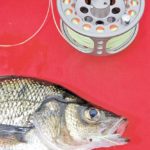
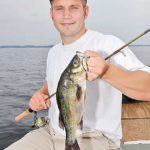
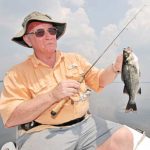
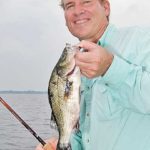
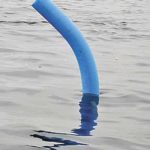
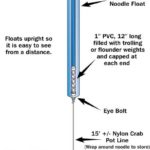



Be the first to comment